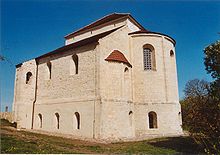Konradsburg
The Konradsburg (first mentioned in 1021) is a castle near Ermsleben in the Harz district in Saxony-Anhalt . It was built to protect the Harz estate . However, neither fortified towers nor a keep or palas are reminiscent of a fortified castle. The castle is managed by the Kulturstiftung Sachsen-Anhalt as owner.
Geographical location
The hill castle is located directly northeast of the Harz low mountain range in the Harz / Saxony-Anhalt nature park . It is located about 6 km west of Aschersleben and about 2 km south of the Falkensteiner district of Ermsleben at 236.2 m above sea level. NHN high castle hill . The settlement of Burggrund with a pond at 198.3 m is located south of the castle by the small Liethe stream .
The Konradsburg is included as no. 201 in the system of stamping points of the Harz hiking pin.
history
Benedictine abbey and Carthusian monastery
After 1120, the left Konrad Burger to about three kilometers south of Ermsleben and about eight kilometers west of Aschersleben nearby mountain spur , built in Selketal the Castle Falkenstein and called off in 1142 only Falkensteiner. A monastery of the Augustinian Canons was founded on the Konradsburg , which was converted into a Benedictine monastery as early as 1133 . It remained a spiritual and economic center of the surrounding area for the following centuries. It is said that the conversion of the castle into a monastery was an atonement for the murder committed by Egeno II von Konradsburg around 1080 on Count Adalbert II von Ballenstedt .
In 1477, Carthusians took over the abbey as Domus Beatae Mariae Annuntiatae in Monte S. Sixti . During the Peasants' War the monastery was burned down in 1525. The monks gave it up in 1526. In 1530, Cardinal Albrecht von Brandenburg , Archbishop of Mainz and Magdeburg and Catholic administrator of the Halberstadt diocese , gave the Charterhouse and its property to the cathedral chapter of Halle .
domain
In 1712 the Konradsburg was used for agricultural purposes ( domain until 1945). In the center of the former cloister is the fountain house, a two-storey half-timbered building that probably dates from the 18th century. It houses over 45 m deep, probably monastery temporal fountain with its technical exhibition facility - a Eselstretrad . The other buildings were built in the 18th and 19th centuries for economic purposes.
After 1945
After 1945 there was a brief agricultural use by individual farmers. Efforts by the city of Ermsleben and the Catholic Church of Aschersleben could, under the conditions at the time, not prevent the Konradsburg from becoming increasingly threatened and neglected in the 1970s. A rapid decline shaped the image of the Konradsburg.
Buildings

Structural and excavated remains show the extent of the former monastery. From the three-aisled, Romanesque basilica , the high choir and the crypt below have been preserved. Despite its simplicity, the choir room impressively conveys the size of the former basilica. The crypt is a five-aisled , groin-vaulted hall, supported by columns and pillars. Capitals and battlements, equipped with a diverse architectural decoration (e.g. Rhenish-French) give evidence of the architecture around 1200. The main features of the buildings adjacent to the church still show the east and north wings of the enclosure area .
Konradsburg sponsorship group
Young people have been involved at the Konradsburg since 1982, supported by students from the Art History Faculty of the Humboldt University in Berlin from 1984 to 1988 . The decay of the plant could be stopped and part of it was made accessible to the public. On June 1, 1990, the initiative founded the Förderkreis Konradsburg e. V., who manages the castle complex. In the following years, the association also took over, renovated and used several endangered architectural monuments in the vicinity, such as the Endorf tower windmill, the old brickworks Wieserode and the forester's house Friedrichshohenberg. In 1994 the association was accepted by UNESCO into the “Treasures of the World” project. Between 2001 and 2009 the association ran a sheep farm at the foot of the castle. The Konradsburg is a station on the Romanesque Road .
Web links
- Konradsburg (Förderkreis Konradsburg), on konradsburg.com
- Konradsburg , in a reconstruction drawing of German castles , on burgrebaus.de
Individual evidence
- ↑ a b Saxony-Anhalt viewer of the State Office for Surveying and Geoinformation ( notes )
- ↑ Harzer Wanderadel: Stamp office 201 / Konradsburg , on harzer-wandernadel.de
- ↑ Analecta Cartusiana , accessed April 22, 2018
Coordinates: 51 ° 42 ′ 51.6 " N , 11 ° 20 ′ 50.3" E




